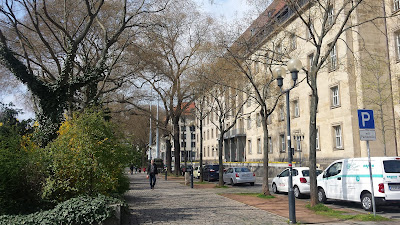Dresden, Germany: Cultural Gem in Saxony Part 2
Dresden as the capital of the Free State of Saxony, an industrial bastion of the former communist East Germany, a former kingdom of Saxony confederated with ancient German Empire as a replacement of the Holy Roman Empire has sufficient factors blending to create a cultural metropolis, a unique gem of its kind. This is the reason why Dresden has interested me as part of my short visit to the German country. In connection to this I have been to several places in the area.
Click here for the Part 1.
1.
Sophienstrabe
This is the street near
Augustus Bridge, which separates the Theater and Dresden Roman Catholic
Cathedral.
2.
Oberlandesgericht
Dresden
The House of Estates is
the seat of power of the Saxon Parliament, on which Dresden is the capital.It
is the only building in the whole Germany on which the three branches of the
government is housed.
3.
Georgenbau
This is the former
residence of the Royal family who used to governed Saxony in Germany. The
building was destroyed by a fire in the 17th century.
4.
Stallhof
This is part of the
Royal Palace complex, which was used for large horse shows. Today, this is used
for cultural events and even as a Christmas market.
5.
Fürstenzug
This is the largest
porcelain artwork in the world. The mural displays exhibits the procession of
the rulers of Saxony in the 18th century. It was made weatherproof
by replacing some of the tiles early 19th century.
6.
Bischöfliches
Sekretariat
The Office of the
Bishop Secretariat is located in the area. This is where coordination of
religious activities and events are made.
7.
Kupferstich Kabinett
This is where the
collection of prints, drawings and photographs are found. It is considered the
oldest museum of graphic arts in Germany.
8.
Residenzschloss
Dresden Castle is
considered one of the oldest buildings in the Saxon capital. This has also been
used as the royal residence of the dynasty that ruled the city before the rise
of the Nazis.
9.
Taschenberg
This is the square
outside the grand hotel in Dresden. This is a place near Zwinger and the
Dresden Castle.
10.
Hotel Taschenbergpalais
Kempinski Dresden
The hotel was used as a
palace of a German countess. It was destroyed during the World War 2 and was
rebuilt in the 1990s. Now, this is considered a five-star hotel.
11. Theaterplatz
This is the historic
town square which was known as the Adolf Hitler Square in the era of national
socialism.
12. Semperoper Dresden
The Saxon State Opera
is the home of the Semperoper ballet. This is considered as one of the most beautiful
opera house in Europe with its Renaissance and Baroque styles.
13. König Johann Denkmal
The Statue of King
Johann is dedicated for the King of Saxony, who was part of the family who
ruled the country in the late 18th century.
14.
Gemäldegalerie
Alte Meister
The Old Masters Gallery
displays Italian Renaissance works, as well as Dutch and Flemish works.
15.
Zwinger
The literal translation
of this place is a killing ground in front of the castle or gate. This was formerly
part of the Dresden fortress, which served as orangery, exhibition gallery and
festival areana.
16. Ostra Allee
This old pathway has a
historic significance. Before, the avenue was named after the Spanish communist
Grimau. Today, many cultural buildings are located along the street.
17.
Staatsschauspiek Dresden
Kleines Haus
The Dresden State
Theatre is the origin in the Royal Court Theatre. The building follows the
Neo-Baroque style.
18. Postplatz
It is central transport
hub in Dresden. It is located in the Old town, which was the site of one of the
main gates of the Dresden fortifications.
19. Altmarkt
This is the oldest
square in Dresden. In 15th century, the place was expanded and the
new market was created.
20. Pfarrgasse
This is the street in
front of the Cross Church, connecting Altmarkt to major highways in Dresden.
21. Kreuzkirche Dresden
This is the main
Protestant church in the city. The church was also burned completely during the
World War 2. This is the reason why many of its blackened stonewalls remained.
22. Ringstrage
This is busy street
infront of the Dresden City Hall. There is a park along its side.
23. Rathausplatz
The New Town Hall is
the seat of Dresden city administration. Both old and new town hall is seen
from the square adjacent to it.
24.
Staftmuseum Dresden
The city museum
displays the 800-year history of Dresden. In the 18th century, the
building was the seat of Saxony.
25. Lingnerallee
This is an interesting
place where recreational activities are available for the Dresden locals.
26. Deutsches Hygiene Museum
This is the medical
museum, which is the forum for science, culture and society. It is one of the
most visited museums in Dresden.
27. Lingnerplatz
Lignerplatz connects
the Lingeralle to the park adjacent to it. It is a quiet place where anyone
could stroll and be with someone.
28.
Blüherpark
The flower public park
in Dresden was a restored park after extensive destruction of German structures
during the Second World War.
29. DDV Stadion
This is the football
stadium in Dresden, which hosts also soccer games.
30. Grober Garten
This oblong-shaped
Baroque style park provides access to Dresden Zoo and Dresden Botanical Garden.
This is a large park located centrally in Dresden.
31. Hauptallee
This is the main street
in Grober Garten. This is simply grandiose and enormous when viewed from the
gate.
32. Zoo Dresden
This is one of the
oldest zoo in Germany and located in the Southern end of the Grober Garten. It
houses more than three thousand animals, especially Asian animals.
33.
Dresdner Parkeisenbahn
This is a park railway
operates along Grober Park. This is an interesting addition to the park, which
provides one the opportunity to see the park in a convenient way.
34. Automobilmanufaktur Dresden
The Transparent Factory
is an automobile production plant of the German carmaker Volkswagen. Cars are
literally displayed in several floors in the transparent building.
Today, Dresden is the tenth largest German metropolis. After 800 years of recorded history, the citizens of Dresden has experienced so significant changes in idealogies, religion and authorities. It has shaped the city to what it is today - a popular tourist destination and a German commercial and industrial region boosting the economy of the largest European economy, Germany.












































Comments
Post a Comment